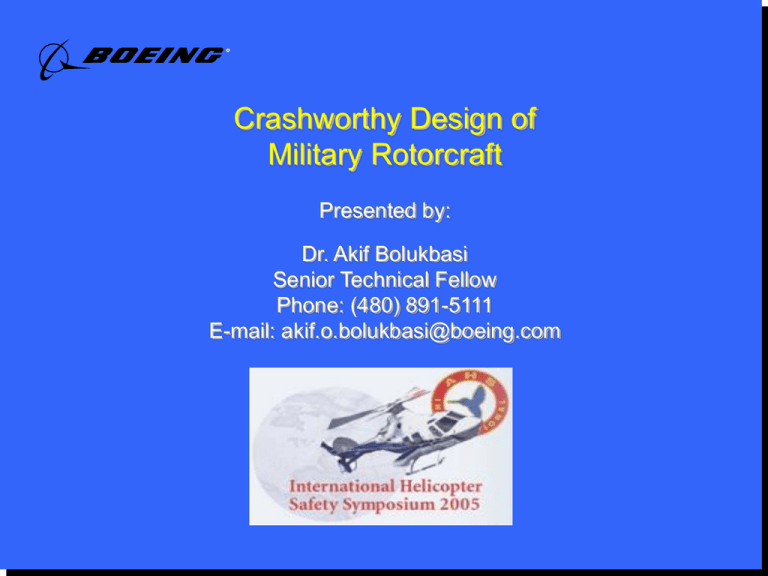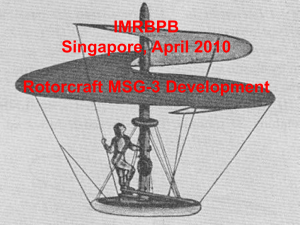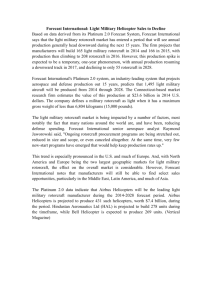AHS Safety Symposium Presentation
advertisement

Crashworthy Design of Military Rotorcraft Presented by: Dr. Akif Bolukbasi Senior Technical Fellow Phone: (480) 891-5111 E-mail: akif.o.bolukbasi@boeing.com Systems Approach to Crashworthy Design Key Subsystems • Landing Gears • Airframe Structure • Seats & Restraint Systems • Fuel Systems Military Rotorcraft Crash Environment Vertical Velocity Longitudinal Velocity Impact Terrain Military Rotorcraft Crashworthiness Design Criteria (MIL-STD-1290) Condition Number 1 2 3 4 5 6 7 Impact Direction (Aircraft Axes) Longitudinal (cockpit) Longitudinal (cabin) Vertical* Lateral, Type I** Lateral, Type II*** Combined high angle* Vertical Longitudinal Combined low angle Vertical Longitudinal Velocity Change V (ft/sec) 20 Object Impacted 42 27 Rigid Vertical Barriers Rigid Horizontal Barriers Rigid Horizontal Surface 14 100 Plowed Soil 40 42 25 30 Military Rotorcraft Crashworthiness Design Criteria (Performance Requirements) Condition Number 1 Impact Direction Longitudinal (Cockpit) Percentage Volume Reduction No serious hazard to pilot/copilot 2 Longitudinal (Cabin) 15% maximum length reduction for passenger/troop compartment 3 Vertical 4&5 Lateral 15% maximum height reduction in cockpit and passenger/troop compartment 15% maximum width reduction 6 Combined High Angle 7 Combined Low Angle No serious hazard to occupant due to cockpit/cabin reduction No serious hazard to occupant Other Requirements Does not impede post-crash egress. Engine, transmission, and rotor system intact and in place Inward buckling of side walls should not pose hazard to occupants or restrict their evacuation Acceleration loads not injurious Lateral collapse of occupied areas not hazardous, no entrapment of limbs. Military Rotorcraft Crashworthiness Design Criteria (Major Mass Item Retention Strength) (1) Applied Separately: Longitudinal Vertical Lateral +/- 20g +20g / -10g +/- 18g (2) Applied Simultaneously Longitudinal Vertical Lateral +/- 20g +10g / -5g +/- 9g +/- 10g + 20g / -10g +/- 9g +/- 10g +10g / -5g +/- 18g Vertical Impact Design Requirements Crash • Sink rates 26 fps (civil), 42 fps (military) • Damage to the fuselage and mission equipment becomes unavoidable. The emphasis is on protecting the occupants from injury. • The fuselage may undergo large deformations but should maintain a livable volume for occupants. • Post crash fires are minimized using crashworthy fuel systems. Landing Gears Normal Landing • Sink Rates 8 - 10 fps • No yielding of the landing gear (military) Hard Landing • Sink rates 10 fps (civil), 20 fps (military) • Emphasis on preventing fuselage and mission equipment damage • Plastic deformation or damage to the landing gear is acceptable Effect of Roll and Pitch Requirements Landing Gear Testing Skid Landing Gears Military Rotorcraft Crashworthiness Design Criteria (Seats) Crashworthy Seat Testing Dynamic Test #1 (Fwd & Down) Dynamic Test #2 (Fwd & Side) Cost-Benefit Trade Study for Crashworthy Rotorcraft Design Conclusions Airframe protective shell to maintain livable volume. Adequate tie-down strength for occupants, cargo, and other heavy mass items. Non-injurious occupant acceleration environment. Delethalized interior to eliminate occupant secondary strike hazards. Elimination or delay of post-crash fire. Adequate emergency escape and rescue provisions.







